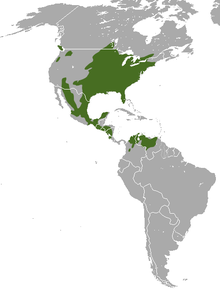Eastern cottontail rabbit
| Eastern cottontail | |
|---|---|
 |
|
| Scientific classification | |
| Kingdom: | Animalia |
| Phylum: | Chordata |
| Class: | Mammalia |
| Order: | Lagomorpha |
| Family: | Leporidae |
| Genus: | Sylvilagus |
| Species: | S. floridanus |
| Binomial name | |
|
Sylvilagus floridanus (J. A. Allen, 1890) |
|
 |
|
| Eastern cottontail range | |
The eastern cottontail (Sylvilagus floridanus) is a New World cottontail rabbit, a member of the family Leporidae. It is one of the most common rabbit species in North America.
The eastern cottontail can be found in meadows and shrubby areas in the eastern and south-central United States, southern Canada, eastern Mexico, Central America and northernmost South America. It is abundant in Midwest North America, and has been found in New Mexico and Arizona. Its range expanded north as forests were cleared by settlers. Originally, it was not found in New England, but it has been introduced there and now competes for habitat there with the native New England cottontail. It has also been introduced into parts of Oregon, Washington, and British Columbia. In the mid-1960s, the eastern cottontail was introduced to Cuba, Jamaica, Cayman Islands, Puerto Rico, Dominican Republic, Barbados, Bahamas, Haiti, Grenada, Guadeloupe, Saint Croix and northern Italy, where it displayed a rapid territorial expansion and increase in population density.
Optimal eastern cottontail habitat includes open grassy areas, clearings, and old fields supporting abundant green grasses and herbs, with shrubs in the area or edges for cover. The essential components of eastern cottontail habitat are an abundance of well-distributed escape cover (dense shrubs) interspersed with more open foraging areas such as grasslands and pastures. Habitat parameters important for eastern cottontails in ponderosa pine, mixed species, and pinyon (Pinus spp.)-juniper (Juniperus spp.) woodlands include woody debris, herbaceous and shrubby understories, and patchiness. Typically eastern cottontails occupy habitats in and around farms including fields, pastures, open woods, thickets associated with fencerows, wooded thickets, forest edges, and suburban areas with adequate food and cover. They are also found in swamps and marshes and usually avoid dense woods. They are seldom found in deep woods.
...
Wikipedia

